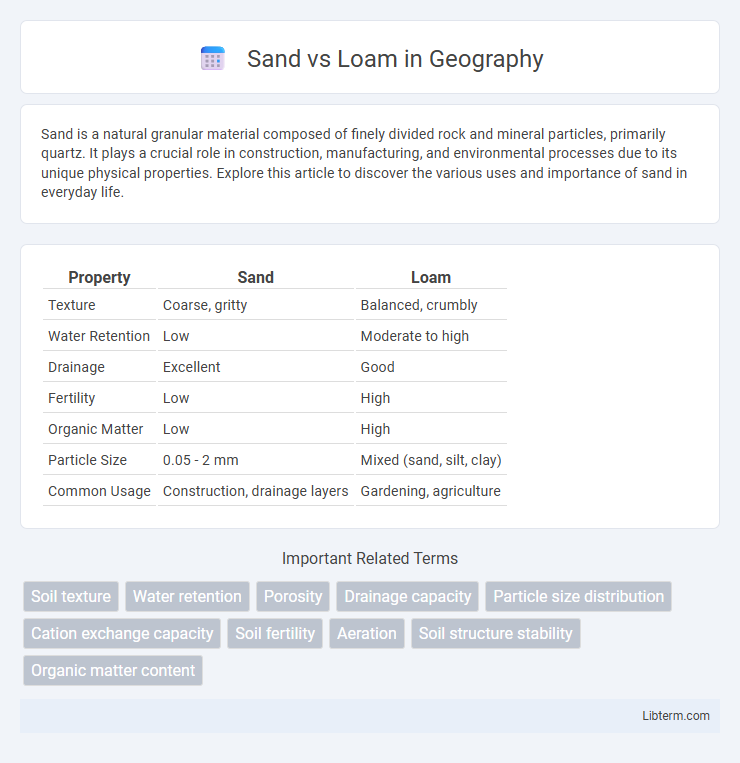Sand is a natural granular material composed of finely divided rock and mineral particles, primarily quartz. It plays a crucial role in construction, manufacturing, and environmental processes due to its unique physical properties. Explore this article to discover the various uses and importance of sand in everyday life.
Table of Comparison
| Property | Sand | Loam |
|---|---|---|
| Texture | Coarse, gritty | Balanced, crumbly |
| Water Retention | Low | Moderate to high |
| Drainage | Excellent | Good |
| Fertility | Low | High |
| Organic Matter | Low | High |
| Particle Size | 0.05 - 2 mm | Mixed (sand, silt, clay) |
| Common Usage | Construction, drainage layers | Gardening, agriculture |
Understanding Sand and Loam: Definitions
Sand consists of coarse, granular particles measuring between 0.05 and 2 mm in diameter, known for excellent drainage and low nutrient retention. Loam is a balanced mixture of sand, silt, and clay, combining good moisture retention with adequate drainage and high fertility. The physical structure of sand promotes aeration but limits water-holding capacity, while loam's composition supports healthy plant growth through optimal nutrient and water availability.
Key Differences Between Sand and Loam
Sand consists of larger, coarse particles that allow rapid water drainage and poor nutrient retention, while loam is a balanced mixture of sand, silt, and clay, providing optimal moisture retention and nutrient availability. Loam's fine texture supports better root growth and soil aeration compared to the gritty, fast-draining nature of sand. Soil fertility, water-holding capacity, and texture are the primary factors that distinguish loam from sandy soil in gardening and agriculture.
Physical Properties and Texture Comparison
Sand has larger, coarser particles ranging from 0.05 to 2.0 millimeters, resulting in gritty texture and excellent drainage but poor nutrient retention. Loam consists of balanced proportions of sand, silt, and clay, giving it a crumbly texture that retains moisture and nutrients efficiently while maintaining adequate aeration. The physical properties of loam make it ideal for plant growth, as its texture supports root penetration and water-holding capacity better than sand alone.
Water Retention and Drainage Capabilities
Sand soils have larger particles that create wide pore spaces, resulting in excellent drainage but poor water retention, causing rapid water runoff and limited nutrient availability. Loam soils balance sand, silt, and clay, offering moderate drainage coupled with high water retention, making them ideal for plant growth by maintaining moisture and nutrients effectively. The enhanced water-holding capacity of loam supports sustained root hydration, while sandy soils require more frequent irrigation due to their quick drying nature.
Nutrient Availability in Sand vs Loam
Loam soil contains a balanced mixture of sand, silt, and clay that provides higher nutrient availability due to better water retention and organic matter content. Sand soil has larger particles, resulting in rapid drainage and poor nutrient retention, which limits essential minerals accessible to plants. The nutrient-holding capacity of loam supports optimal plant growth by supplying consistent levels of nitrogen, phosphorus, and potassium compared to sandy soil.
Plant Growth: Which Soil is Better?
Loam soil, composed of balanced sand, silt, and clay, offers superior plant growth conditions due to its optimal nutrient retention, moisture balance, and aeration compared to sand. Sand drains quickly but lacks nutrients and water retention, making it less ideal for sustained plant development. Gardeners and agricultural experts prefer loam for its ability to support strong root systems and healthy, vigorous plant growth.
Agricultural and Gardening Applications
Sand offers excellent drainage and aeration, making it ideal for crops requiring well-drained soils like root vegetables and succulents. Loam, with its balanced mixture of sand, silt, and clay, retains moisture and nutrients effectively, supporting a wide range of plants in both agriculture and gardening. Farmers and gardeners prefer loam for its fertility and structure, promoting robust plant growth and sustainable soil health.
Soil Preparation and Maintenance Tips
Sand requires thorough soil preparation involving the incorporation of organic matter to improve nutrient retention and water-holding capacity, addressing its naturally quick drainage and low fertility. Loam, characterized by a balanced mixture of sand, silt, and clay, often needs less amendment but benefits from regular aeration and the addition of compost to maintain optimal structure and moisture levels. Consistent mulching and monitoring soil pH are essential practices for both sand and loam to sustain healthy plant growth and enhance soil life.
Environmental Impact: Erosion and Sustainability
Sand soils, characterized by large particles and low cohesion, are highly susceptible to erosion due to wind and water, leading to nutrient depletion and increased sediment runoff into water bodies. Loam soils, with a balanced mixture of sand, silt, and clay, offer superior water retention and root support, significantly reducing erosion risks and promoting long-term soil fertility. Sustainable land management practices in loam areas enhance carbon sequestration and biodiversity, whereas sandy soils require frequent amendments and erosion control measures to maintain environmental stability.
Choosing the Right Soil for Your Needs
Sand offers excellent drainage and is ideal for plants requiring quick water runoff, while loam provides a balanced mixture of sand, silt, and clay, ensuring optimal moisture retention and nutrient availability. Selecting the right soil hinges on the specific needs of your plants and local climate, with loam being preferred for general gardening due to its fertility and structure. Understanding soil pH, texture, and organic matter content helps tailor the choice between sand and loam to maximize plant growth and health.
Sand Infographic

 libterm.com
libterm.com